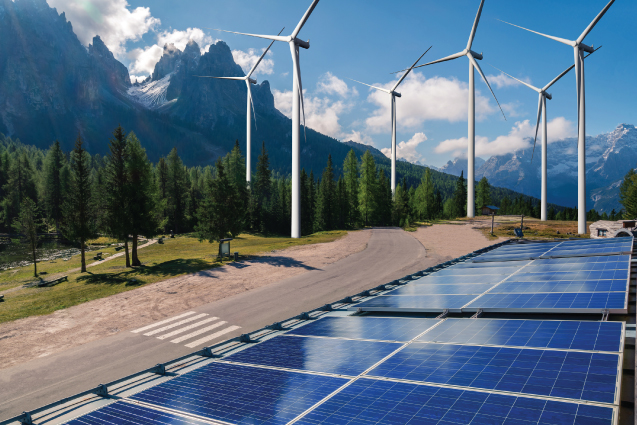
Global
According to the International Renewable Energy Agency, in an era of accelerating change, the imperative to limit climate change and achieve sustainable growth is strengthening the momentum of the global energy transformation.

The rapid decline in renewable energy costs, improving energy efficiency, widespread electrification, increasingly “smart” technologies, continual technological breakthroughs and well-informed policy making all drive this shift, bringing a sustainable energy future within reach.
Renewable energy needs to be scaled up at least six times faster for the world to start to meet the goals set out in the Paris Agreement. The share of renewable energy in the power sector would increase from 25% in 2017 to 85% by 2050, mostly through growth in solar and wind power generation. This transformation would require new approaches to power system planning, system and market operations, and regulation and public policy.
A third of global power capacity is now based on renewable energy. The sector added 171 GW of generating capacity in 2018. While Asia accounted for 61 per cent of total new renewable energy installations and grew installed renewables capacity by 11.4 per cent, growth was fastest in Oceania that witnessed a 17.7 per cent rise in 2018. Africa’s 8.4 per cent growth put it in third place just behind Asia. Nearly two-thirds of all new power generation capacity added in 2018 was from renewables, led by emerging and developing economies.
India
India, now, has a golden opportunity to shape its energy mix. Social and economic growth are at the top of the government’s agenda, and new energy sources to serve this demand are increasingly coming from renewable energy. A number of factors have contributed to this. The government policy has been supportive, and more recently, a wider set of actions—incentives, infrastructure and investment promotions were taken up. Technology development, larger-scale projects and the learning effect has allowed the use of efficient designs and have pushed down costs. This makes renewable energy attractive to power utilities that are contracting new long-term capacity,

India’s renewable energy capacity has crossed the 80GW-mark, which includes 29.55 GW of solar energy and 36.37 GW wind power. The government has set an ambitious target of having 175 GW of clean energy capacity by 2022, including 100 GW solar and 60 GW of wind energy.
After a year of relative lull, renewable energy will be back on track in 2019 with new plants being set up and the introduction of the much anticipated policy on battery storage. This will also be the year when floating solar projects will add significant capacity to the country’s generation scene, according to the India RE 2019 Outlook published by renewable energy consultancy Bridge to India.
Total renewable energy capacity addition in 2019 will be 15,860 megawatts (MW), up 50% compared to 2018.
Telangana
According to a NitiAyog, report credit for the transformation of Telangana from power deficit to power surplus should go to the rapidly-growing power sector in the state. Over the years, the sector has ramped up supply, especially of the renewable component, gradually bridging the demand-supply gap. The state has an overall Renewable Energy potential of 24 GW. The newly-formed state has emerged as one of the top performers in the solar sector, despite being a land-locked state. Renewables currently constitute ~13.4% of the total 11.5 GW capacity in the state. The Telangana State Renewable Energy Development Corporation Limited (TNREDCL) is the nodal agency for establishing Renewable Energy in the state. As of June 2016, 100% of households were electrified.
State efforts to encourage Renewable Energy
The state has adopted a multi-pronged strategy to embrace Renewable Energy in the state. In order to increase the deployment of solar energy projects and create a favorable environment in the state, Telangana announced a Solar Power Policy in 2015. The state has made substantial achievements in the solar segment, including:

Solar pumps: Telangana has been focusing on improving performance and making technology eco-friendly, as well as adopting measures to increase participation levels. The state has followed a unique strategy to effectively utilize solar energy. It powers its pump sets during the daytime, which helps it divert excess solar power, and thus avoid the significant problems of power evacuation or grid integration.
Solar rooftop: Due to low land availability, Telangana has shifted its focus from ground-mounted to decentralized generation (that is, solar rooftop). The state plans to be aggressive in the coming years to expand its rooftop capacity. Some key incentives leading to high solar capacity additions in the state include exemptions from electricity duty, VAT, wheeling and transmission charges (for captive use) within the state, CSS, stamp duty, land ceiling, 100% banking facility, CDM benefits and PCB clearances.
Solar Policy framework– Click Here for PDF

State roadmap for 2022
By adopting the policy initiatives stated above, Telangana has charted a future trajectory for itself. The state has targeted an overall generation capacity of 16,000 MW by FY18 (both conventional and non-conventional), with 2,500 MW Renewable Energy addition (mostly solar). Decentralized, generation-based capacity addition is its top priority in the coming years. Other initiatives include.
- To match demand and supply, the state would increase power demand by promoting the adoption and use of electric vehicles, promote power consumption through tariff-based incentives, and devise inter-state power supply arrangements.
- Competitive bidding for the wind to be introduced to increase deployment of wind projects in the state.
- Solar pumps: Create a pool of skilled local technicians near villages to address agri-pump issues. At the same time, incorporate solar pump sets with battery storage facility so that additional power can be stored and utilized for other purposes such as lighting (at night) in off-grid areas.
- Renewable Energy storage technology to be focused in the state: that is, deployment of battery storage-based solar projects.
All these efforts are creating a vibrant ecosystem for companies involved in generation and manufacturing in the sector to put Telangana on top of the list in their expansion plans in the sector.




